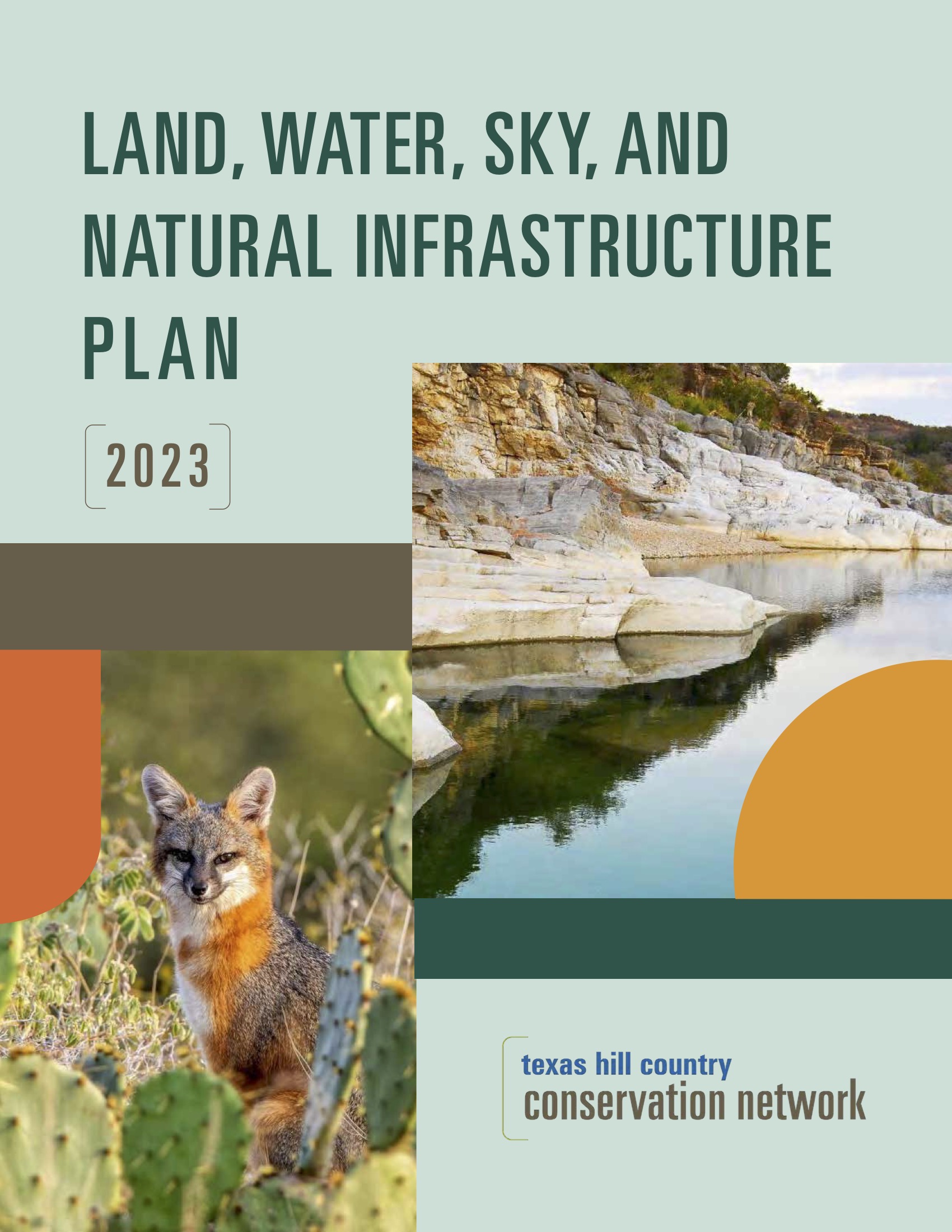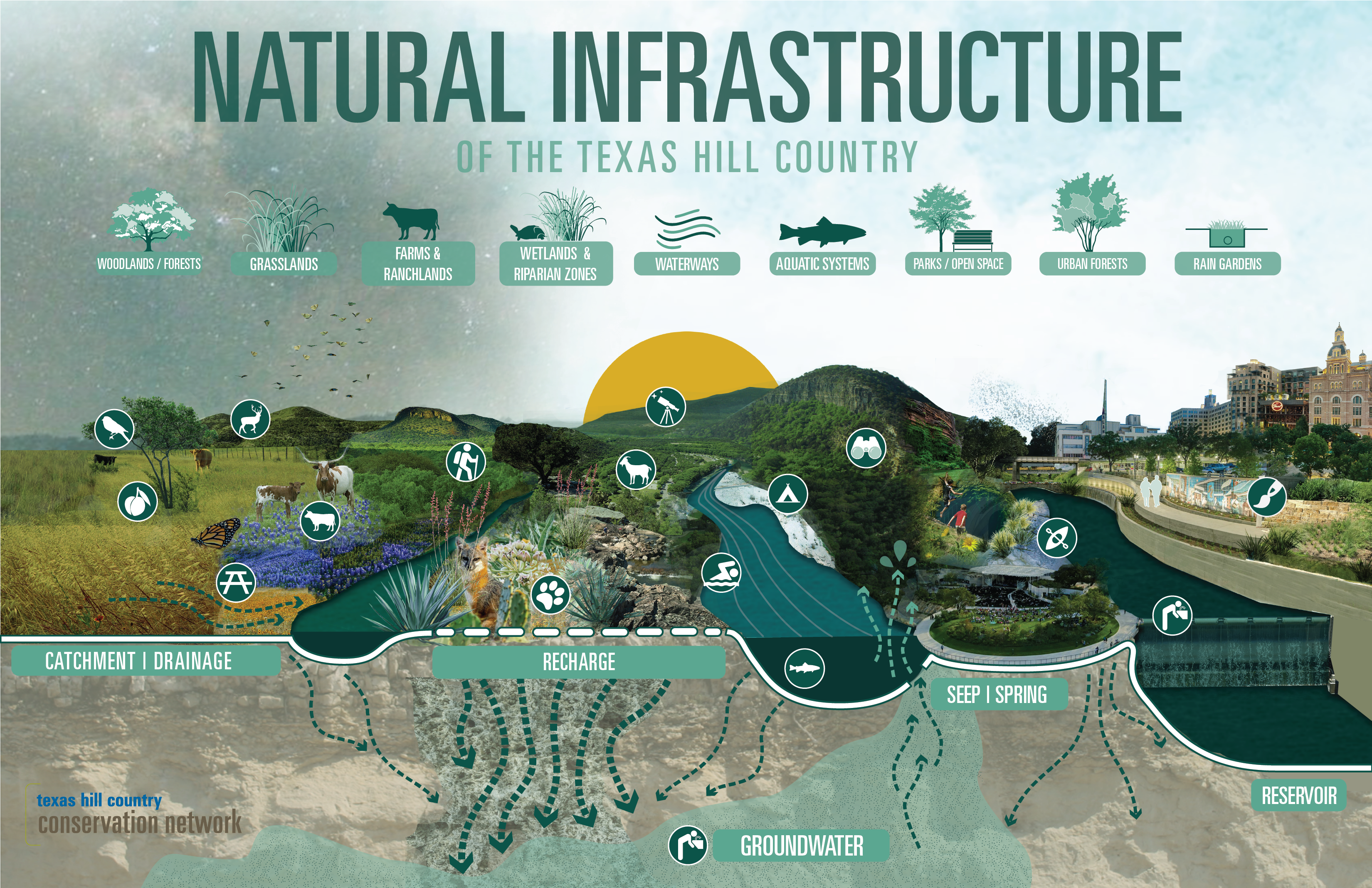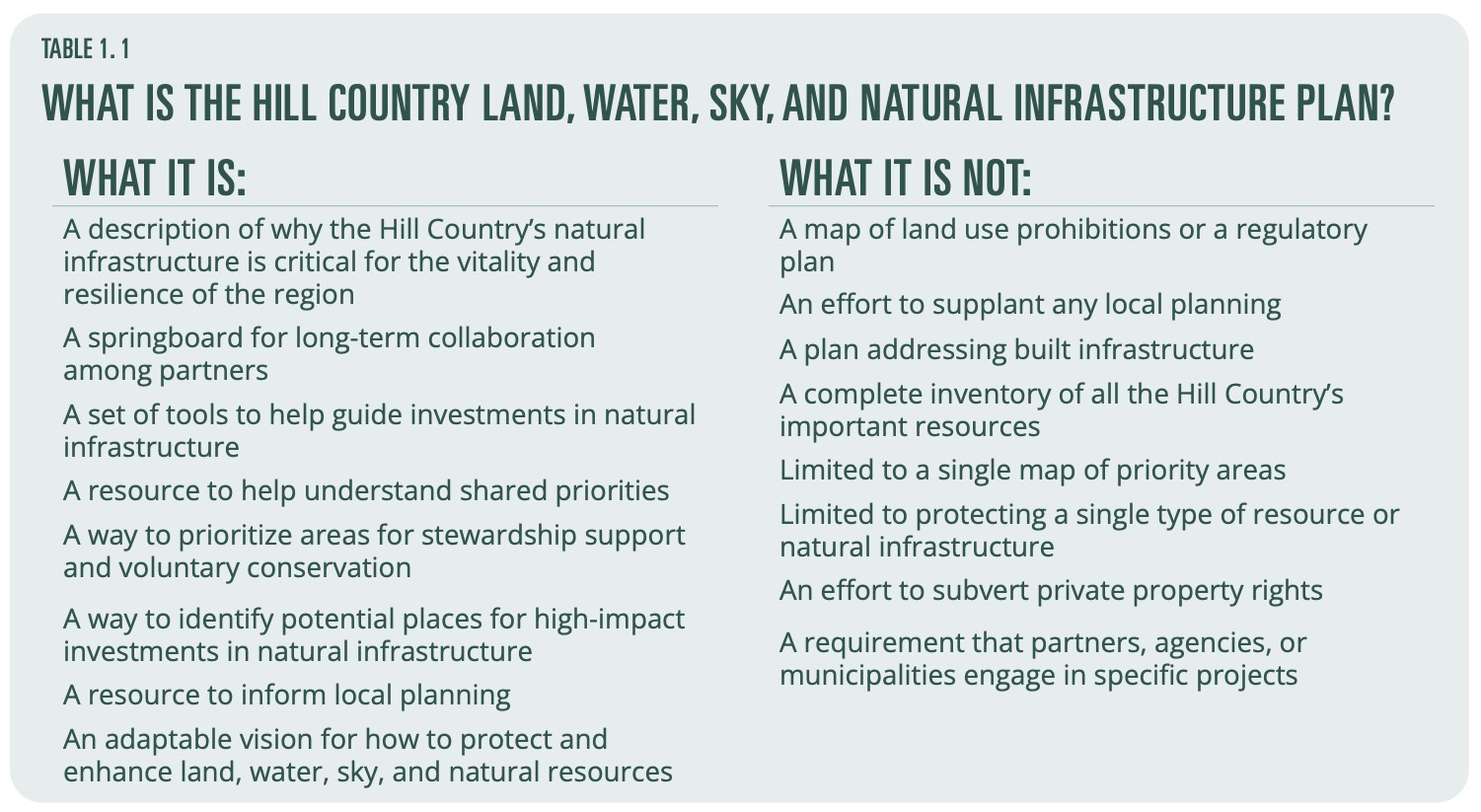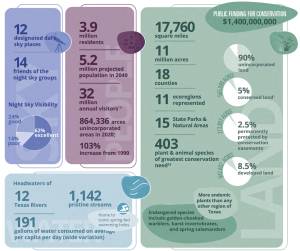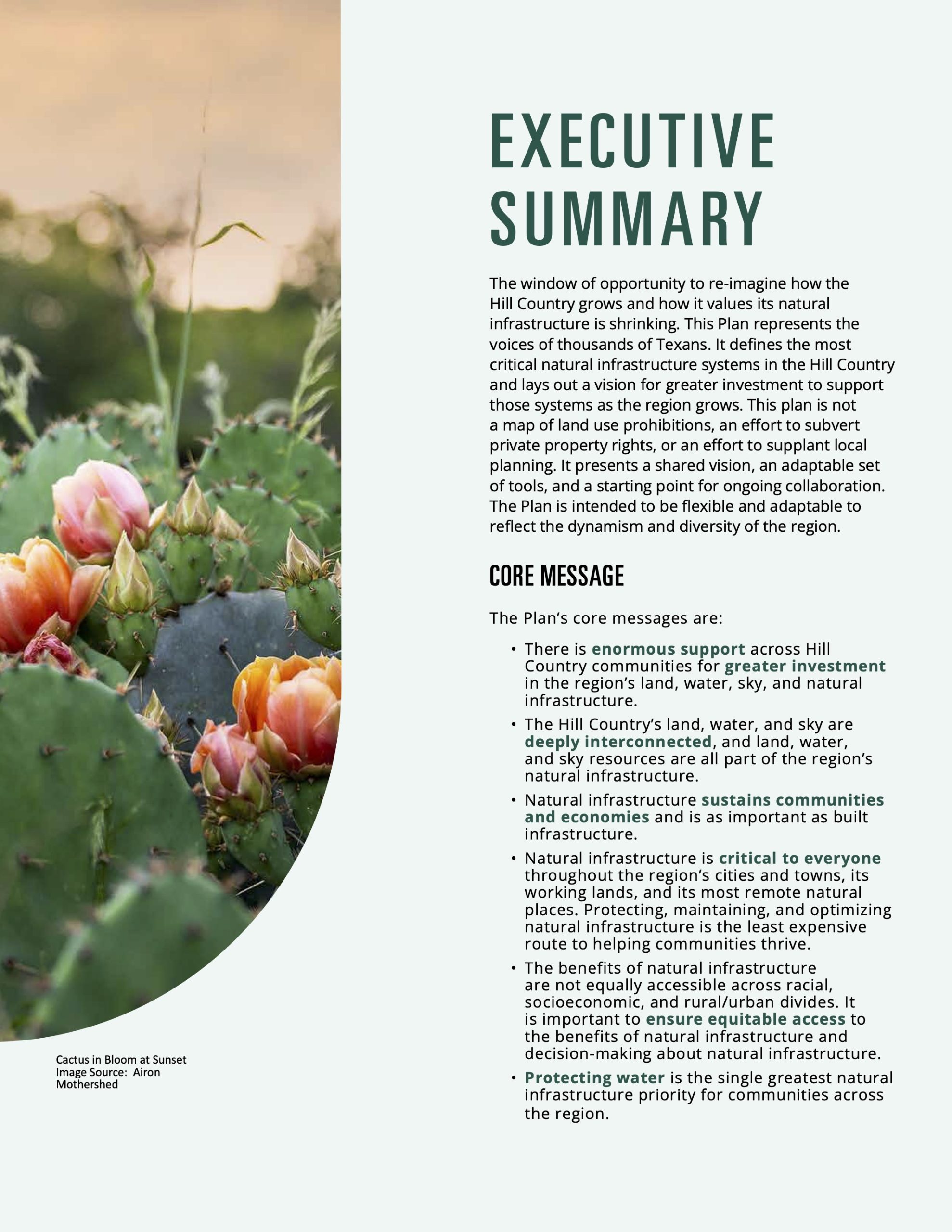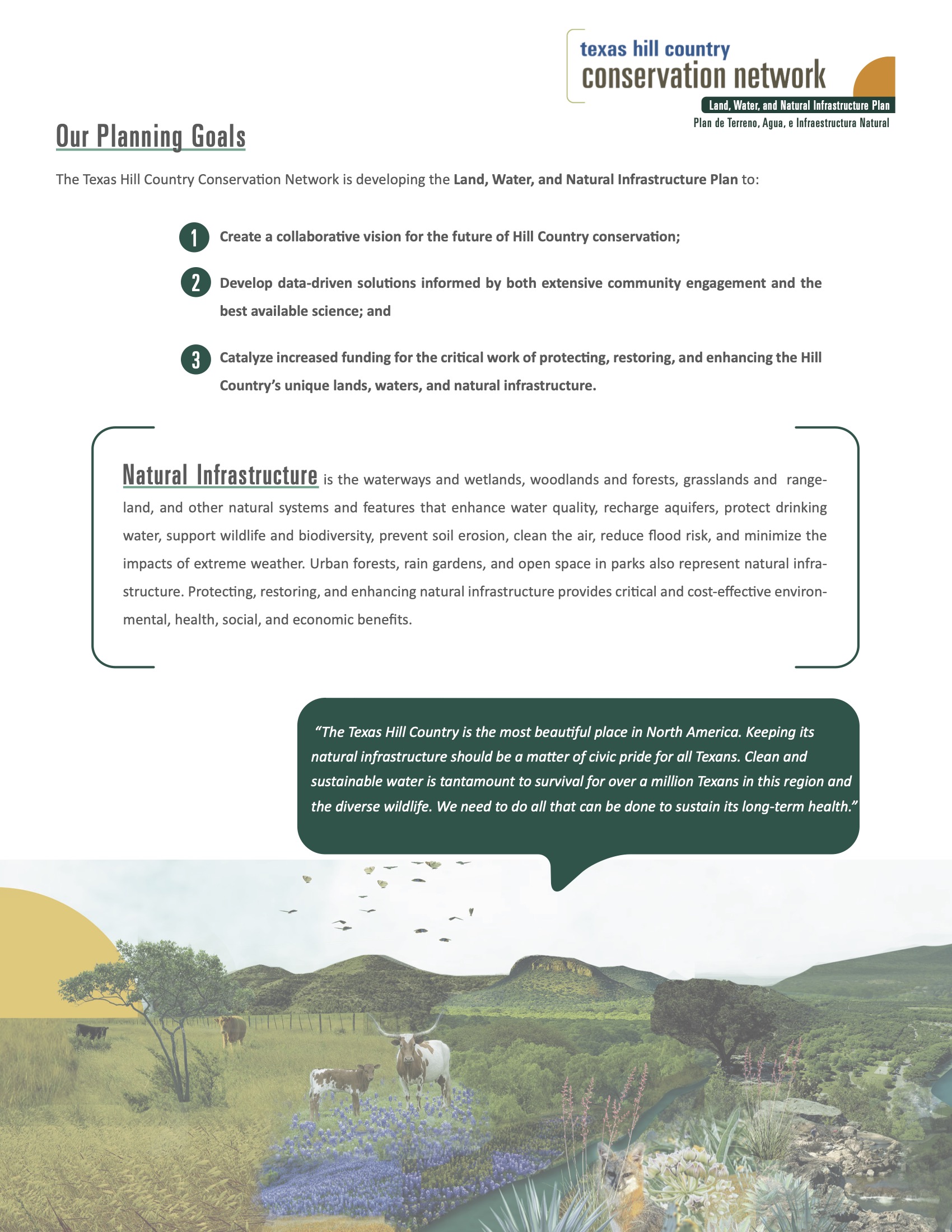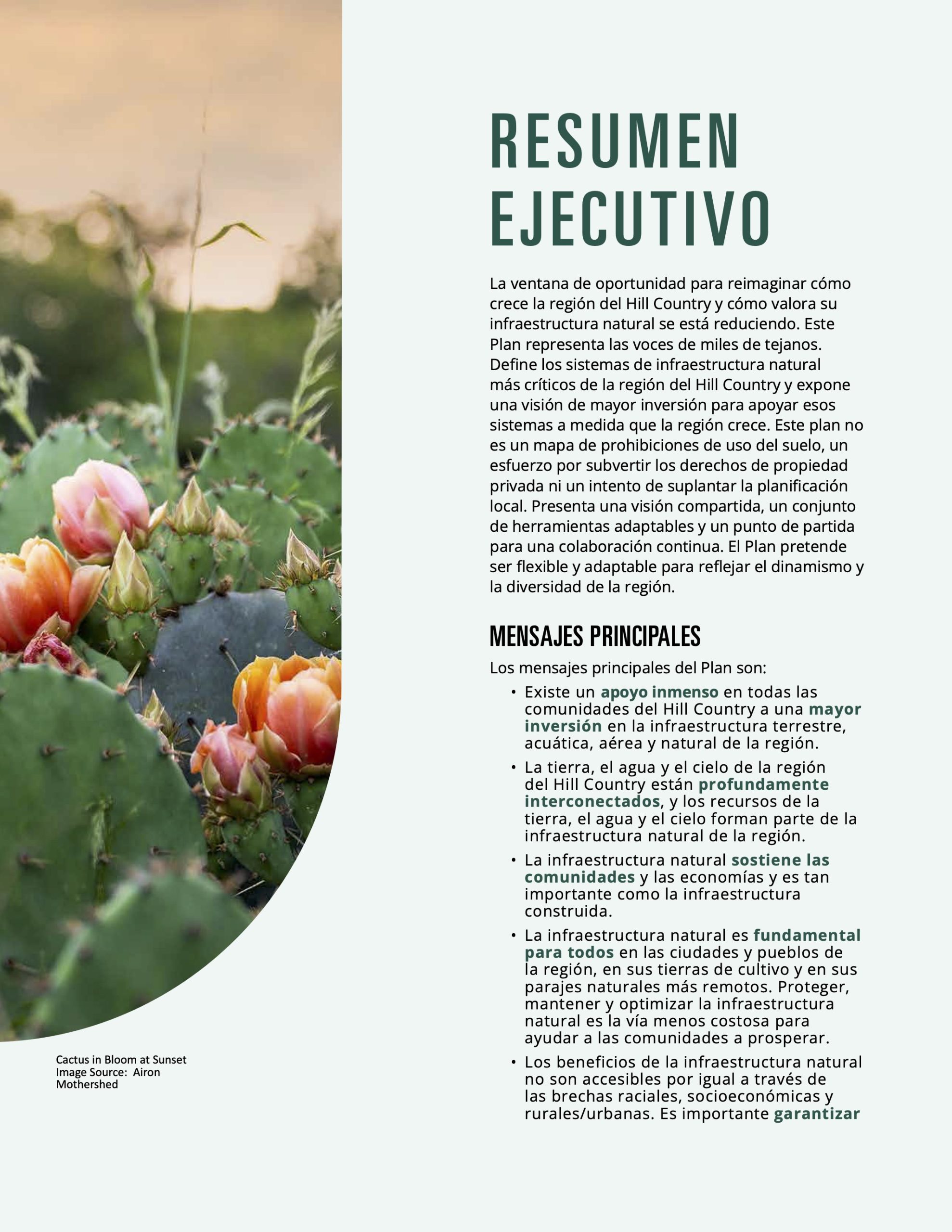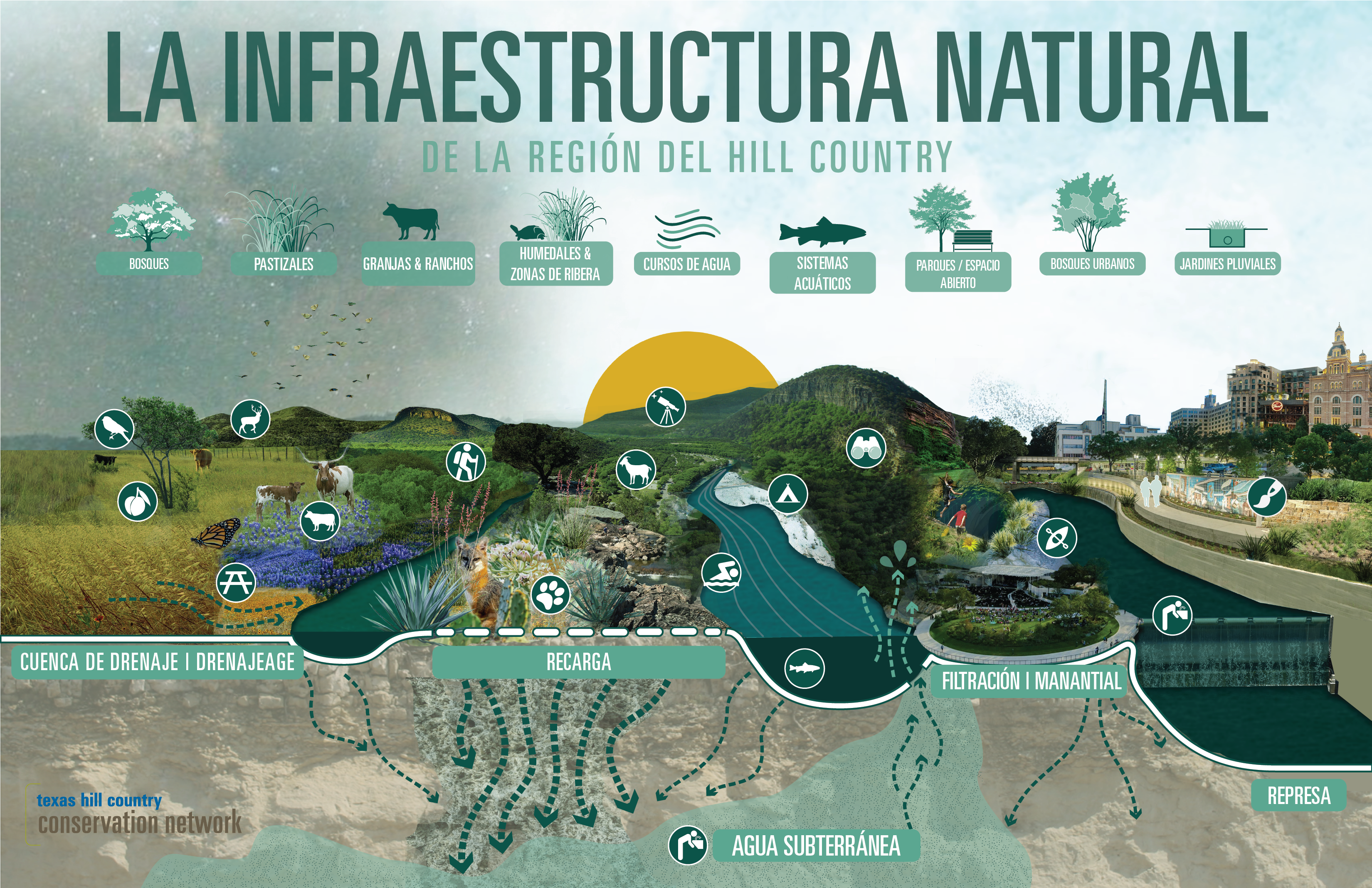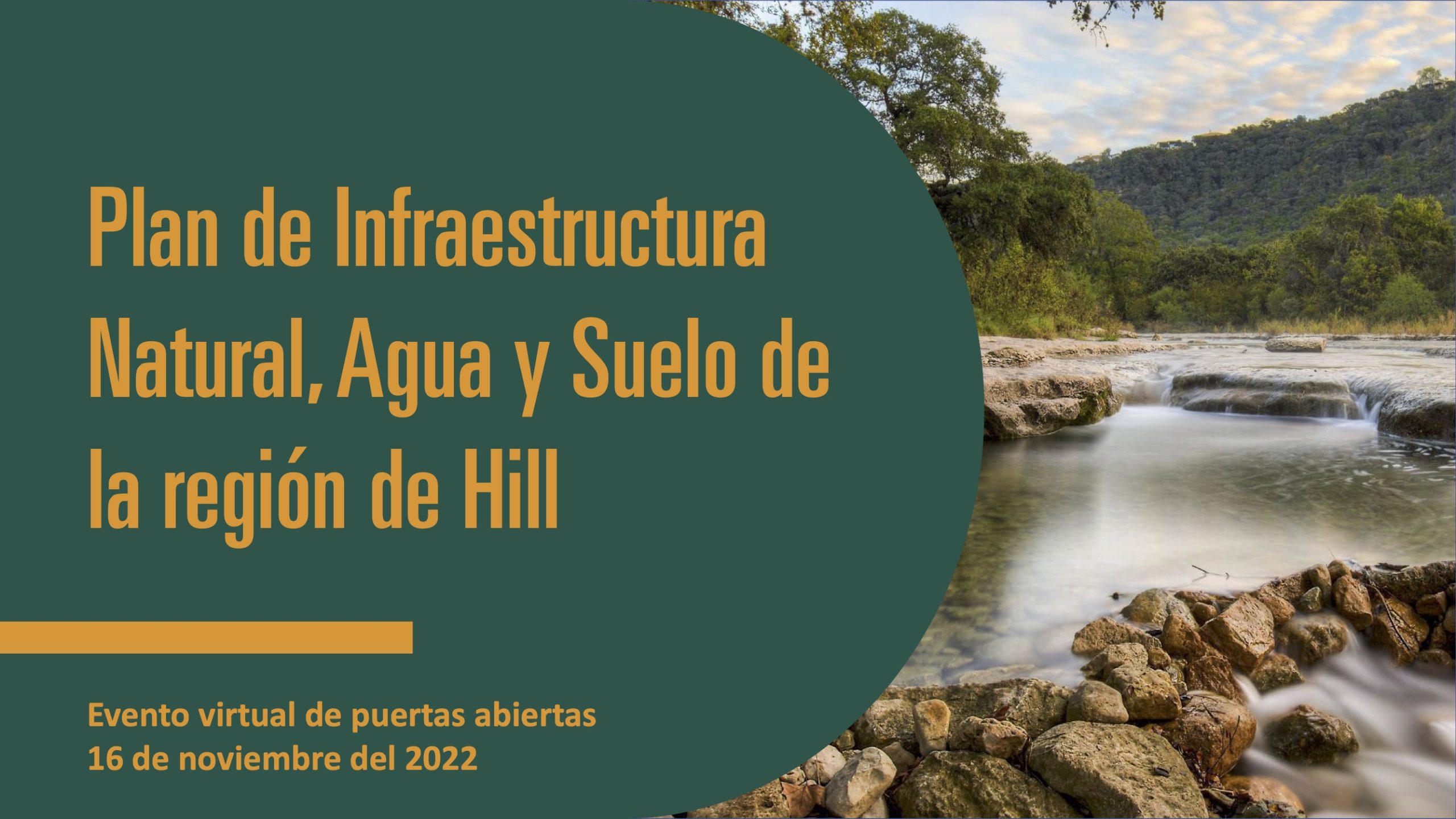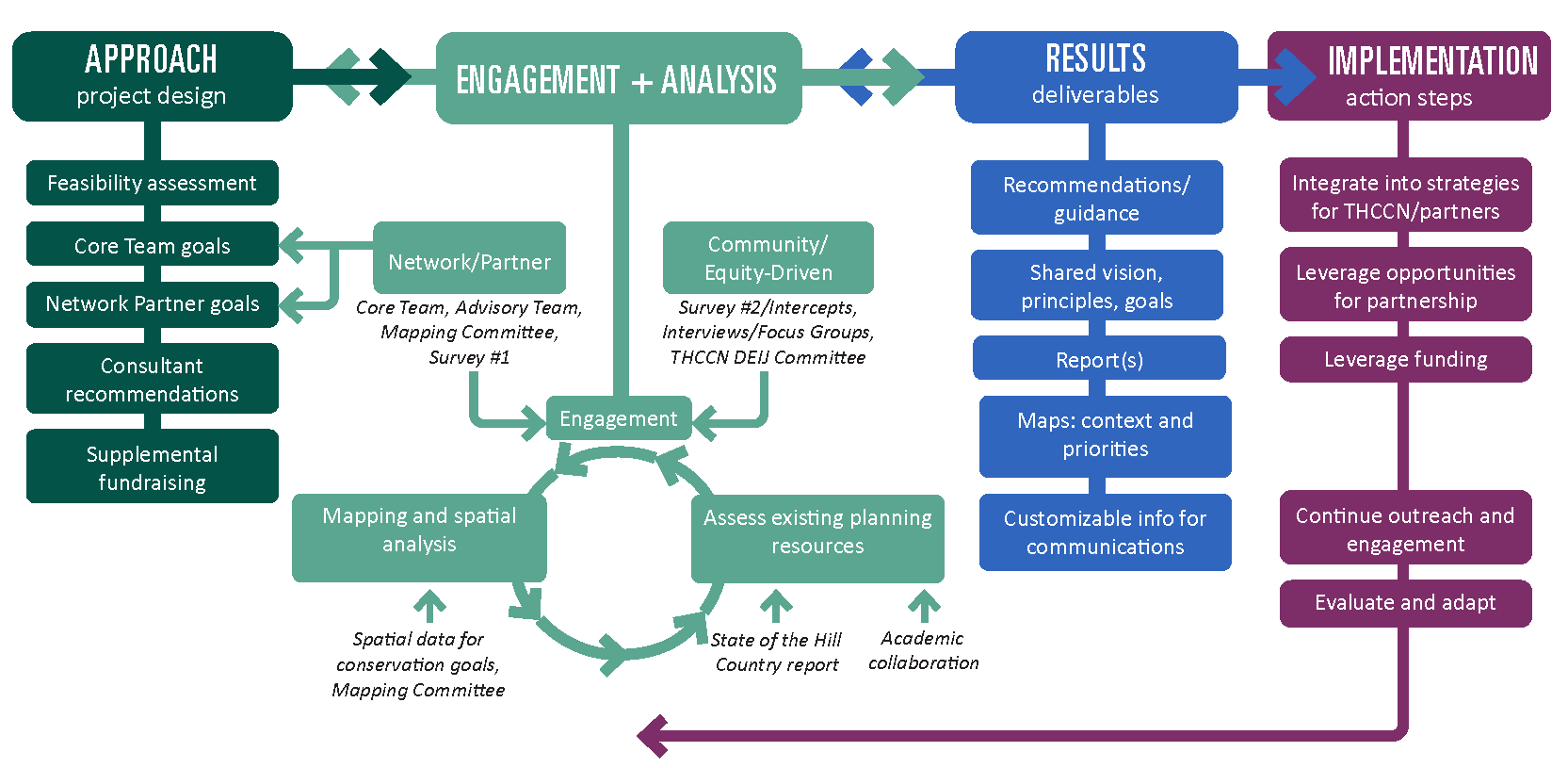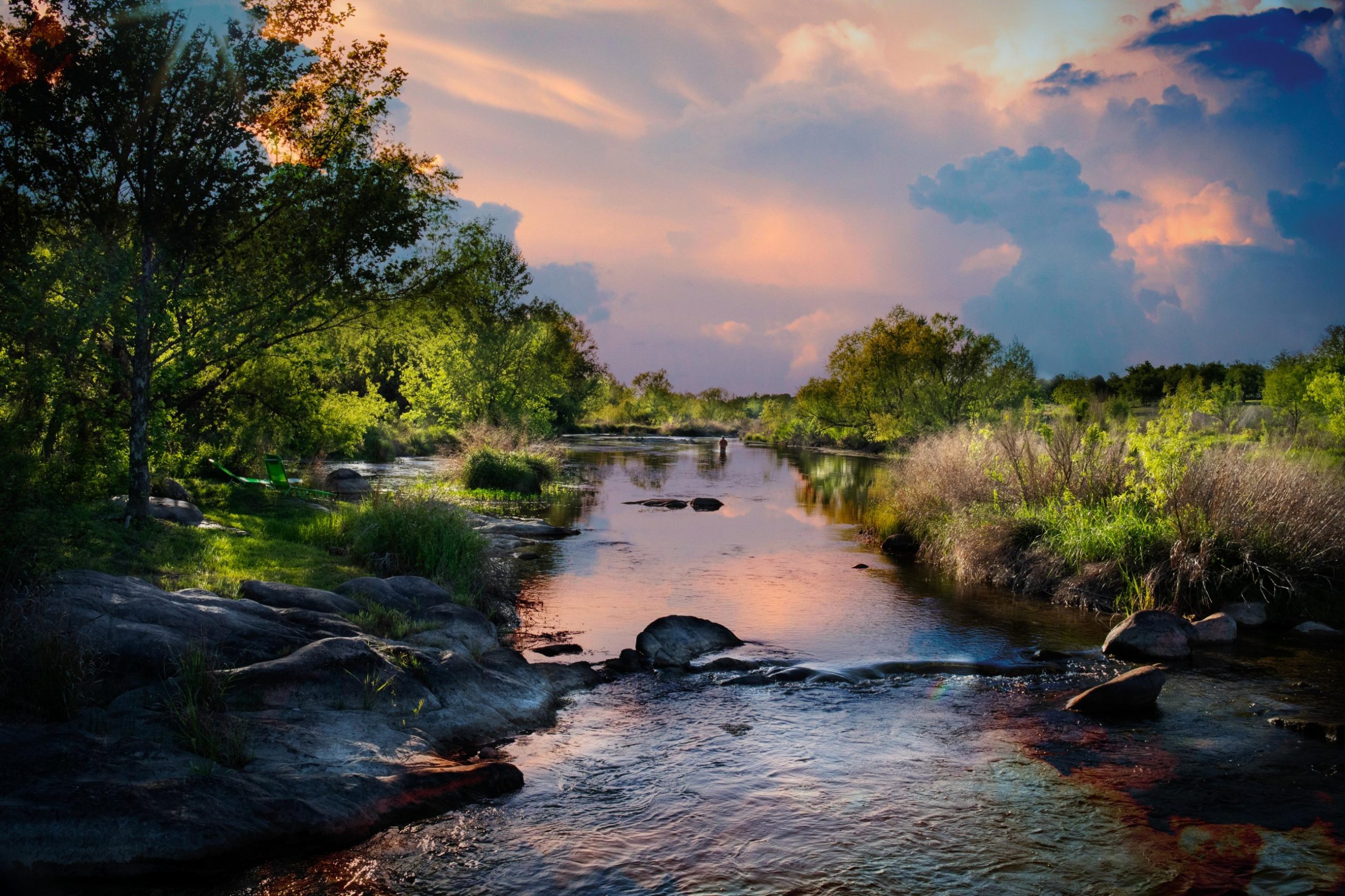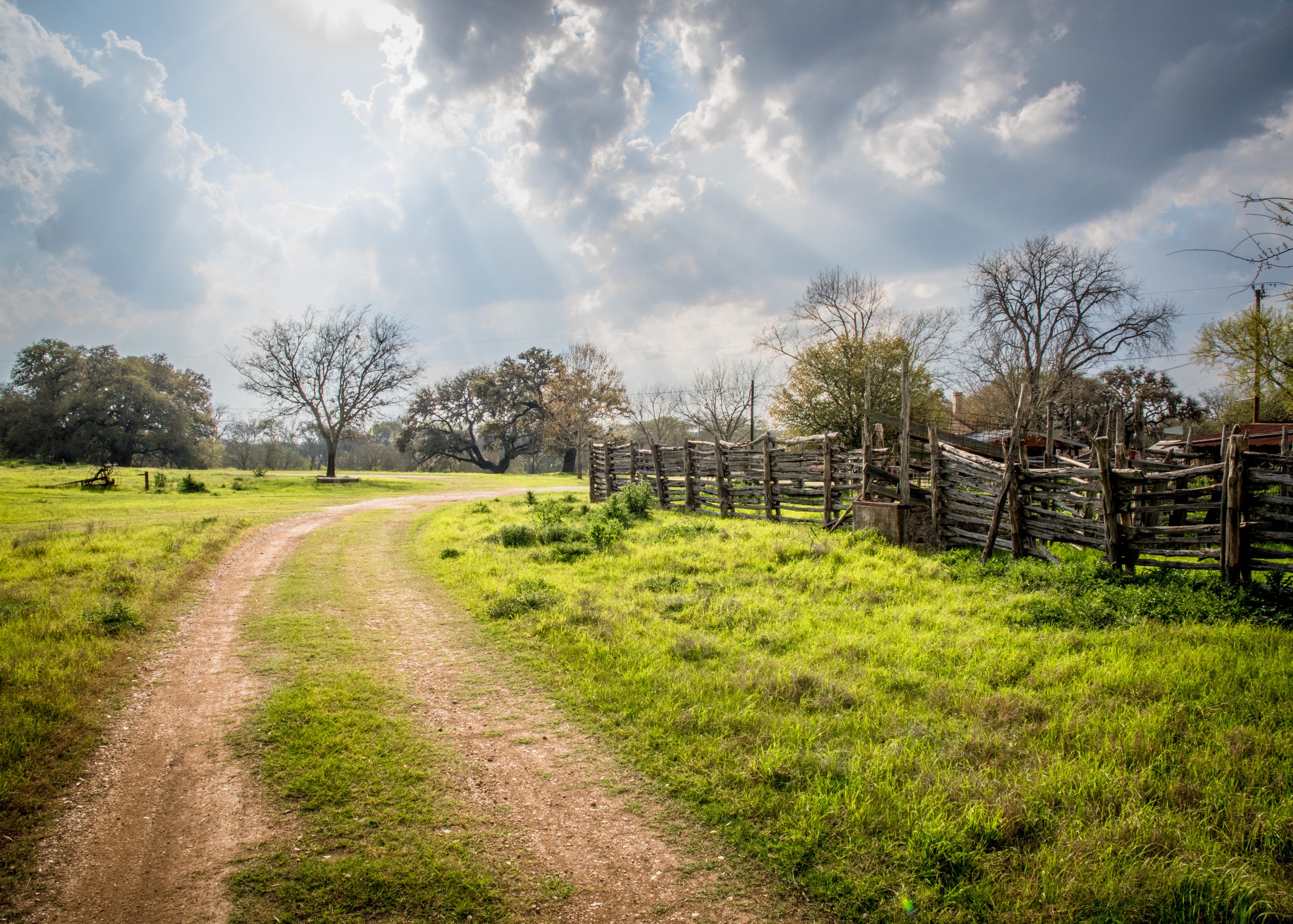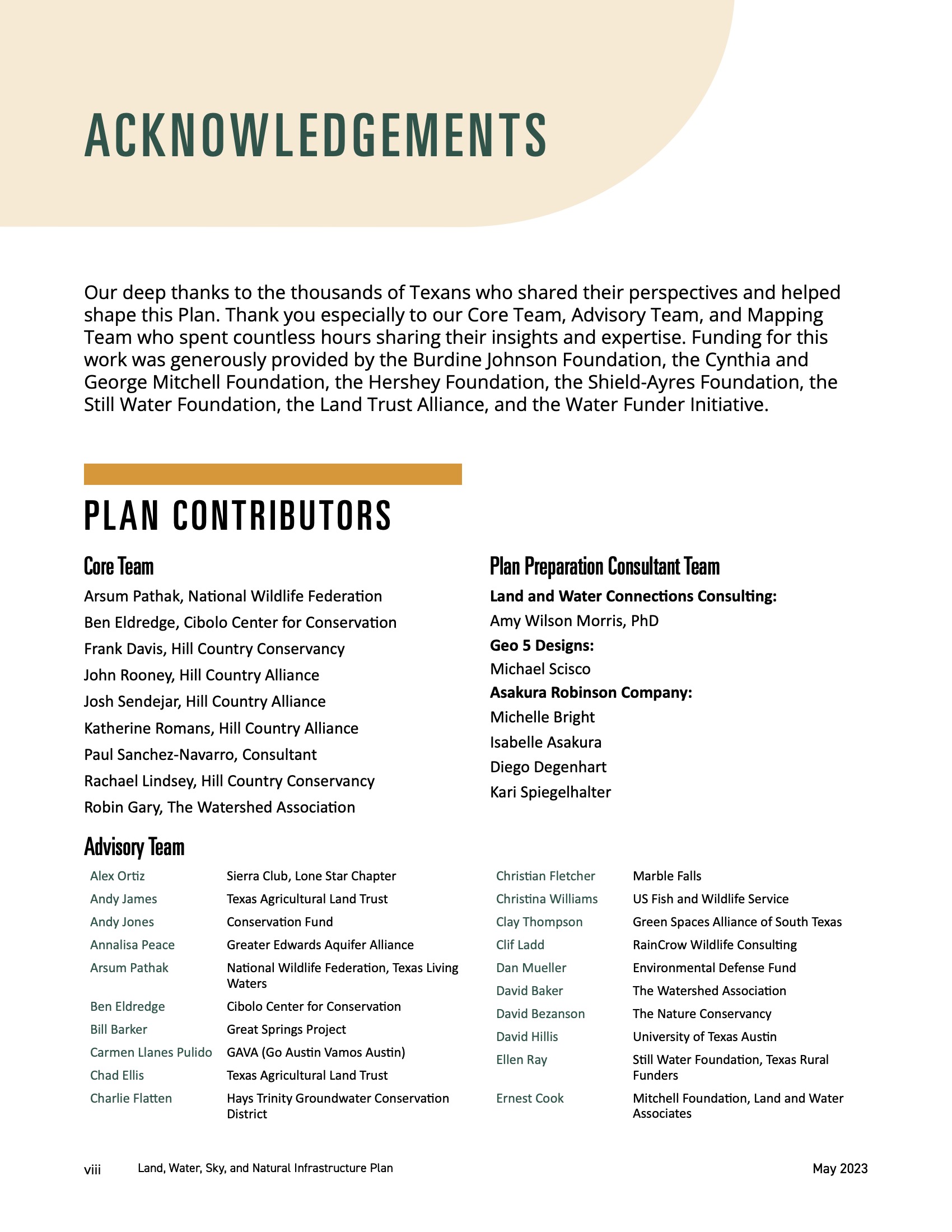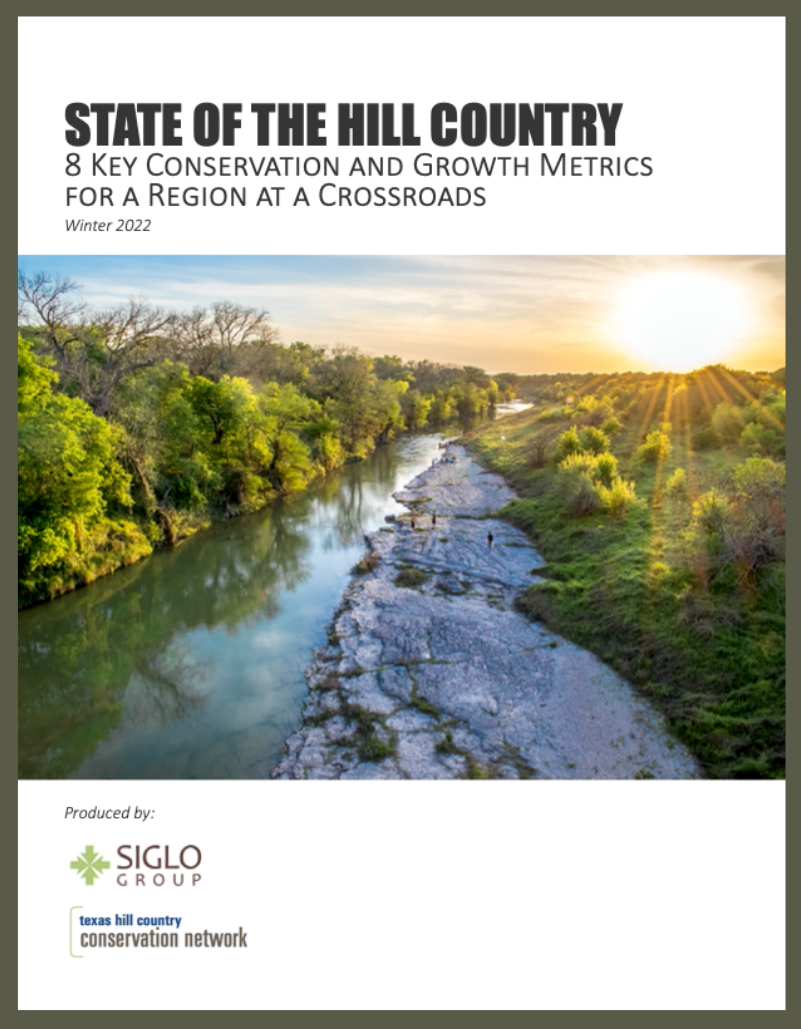Land, Water, Sky, and Natural Infrastructure Plan

A Natural Infrastructure Plan for the Hill Country
The Texas Hill Country Conservation Network is proud to release the Hill Country Land, Water, Sky, and Natural Infrastructure Plan. This plan includes a shared vision for the Hill Country, collaboratively developed infographics, and objectives & strategies for achieving the Plan’s vision. Through the development of this plan, the Network seeks to steward important natural lands and resources, sustain healthy farms, ranches, and working forests, and expand opportunities for connecting to nature.
Land, Water, Sky, and Natural Infrastructure Plan
The Hill Country Land, Water, Sky, and Natural Infrastructure Plan aims to provide data-driven solutions and priorities for conserving natural resources within the Texas Hill Country and includes a written report, maps, and recommendations for a path forward. The development of the Natural Infrastructure Plan drew from the feedback of thousands of central Texans, including natural resource professionals, residents, elected officials and landowners within the region.
Natural Systems are Vital Infrastructure
A central theme throughout the new plan is the reframing of infrastructure to move beyond built systems and include the natural systems that sustain Hill Country communities. From rivers and aquifers that provide our communities drinking water to the rolling hills that provide flood mitigation, these natural features provide vital services and protections throughout the region. The Hill Country Land, Water, Sky, & Natural Infrastructure Plan highlights where protection of these resources is most needed, and identifies opportunities for improving recreational access to nature, mitigating urban heat island impacts, and protecting our precious water resources.
Natural infrastructure is the cornerstone of thriving and resilient economies and an essential foundation of community health and safety.
Studies show that for every $1 invested in conservation, $4 to $11 is returned in natural goods and services like clean air and water and reduced risk of flooding. Click to learn more.
Texas working lands provide $629/acre/year in benefits, which totals $89 billion annually across 141 million acres. Click to learn more.
Close-to-home access to green space lowers rates of major diseases and improves physical and mental health—avoiding significant health-care costs. Click to learn more.
Key Takeaways
- There is enormous support across Hill Country communities for greater investment in the region’s land, water, sky, and natural infrastructure.
- The Hill Country’s land, water, and sky are deeply interconnected, and are all part of the region’s natural infrastructure.
- Natural infrastructure sustains communities and economies and is as important as built infrastructure.
- Natural infrastructure is critical to everyone throughout the region’s cities and towns, its working lands, and its most remote natural places. Protecting, maintaining, and optimizing natural infrastructure is the least expensive route to helping communities thrive.
- The benefits of natural infrastructure are not equally accessible across racial, socioeconomic, and rural/urban divides. It is important to ensure equitable access to the benefits of natural infrastructure and to decision=making about natural infrastructure.
- Protecting water is the single greatest natural infrastructure priority for communities across the region.
Take a Closer Look…
WHAT IS NATURAL INFRASTRUCTURE?
As shown in this graphic, natural infrastructure includes the woodlands and forests, grasslands, wetlands, rangeland, and other natural systems and features that enhance water quality, recharge aquifers, protect drinking water, support wildlife, prevent soil erosion, clean the air, reduce flood risk, and minimize the impacts of extreme weather. In cities and towns, urban forests, rain gardens, and open space in parks also represent natural infrastructure. Protecting, restoring, and enhancing natural infrastructure provides critical and cost-effective environmental, health, social, and economic benefits.
WHAT ARE THE BENEFITS OF INVESTING IN NATURAL INFRASTRUCTURE?
- Providing clean and abundant water
- Keeping farm and ranch lands intact and viable
- Preserving dark skies
- Providing places to recreate and exercise outdoors
- Providing places to fish and hunt
- Promoting biodiversity
- Reducing water treatment costs
- Generating tourism and recreation dollars
- Attracting new businesses
- Supporting pollination of crops and other plants
- Reducing wild fire risk
- Reducing drought intensity
- Providing wildlife habitat Including rare and threatened species
- Promoting economic viability of rural and agricultural lands
- Collecting and storing water (aquifer recharge) • Reducing the impacts of extreme weather
- Reducing intensity of flooding
- Reducing water and air pollution
- Reducing health impacts from extreme heat • Creating and maintaining healthy soils
- Helping people connect with nature
- Increasing social connections
- Supporting early childhood development
- Providing places to play, gather, and spend time together
- Providing mental health benefits from spending time in nature
- Protecting culturally and spiritually sacred places
- Providing strong regional identity and sense of place
WHAT IS THE LAND, WATER, SKY, AND NATURAL INFRASTRUCTURE PLAN?
The Plan is not just about traditional land conservation. It’s about the Hill Country’s waters and skies and an expansive view of natural infrastructure across the entire region from its cities and towns to its ranchlands and remote rural areas. The acknowledgment that natural infrastructure is critical to thriving communities and economies is central to this effort. This is not intended to be a static plan but rather an adaptable set of tools, a shared vision, and a starting point for ongoing collaboration and increased collective impact.
WHO MADE THE PLAN?
This Plan, the public opinion research, graphics, and maps that follow are the culmination of hundreds of hours of input and work from residents across the Hill Country. We – the Texas Hill Country Conservation Network – connected with farmers, ranchers, elected officials, river enthusiasts, city dwellers, business owners, and stargazers from communities big and small to create this Plan.
Through all our conversations and across all our efforts to engage with people who live and work in the Hill Country, one thing was consistent and clear: Central Texans love the Hill Country and see the value of protecting the natural infrastructure that defines it.
On behalf of the Core Team for the Land, Water, Sky, and Natural Infrastructure Plan, thank you for your interest. We hope this Plan will inspire you to look at natural infrastructure differently in your community. Click here to learn more about the organizations involved in the plan’s creation.
Core Team Members:
- Arsum Pathak, National Wildlife Federation
- Ben Eldredge, Cibolo Center for Conservation
- Frank Davis, Hill Country Conservancy
- Josh Sendejar, Hill Country Alliance
- Katherine Romans, Hill Country Alliance
- Paul Sanchez-Navarro, Consultant
- Rachael Lindsey, Hill Country Conservancy
- Robin Gary, The Watershed Association
WHY IS THE PLAN NEEDED?
The window of opportunity to re-imagine how the region grows and how it values its working lands and other natural infrastructure is shrinking.
If development is not balanced with strategic investments in conservation and natural infrastructure, we will lose much of what makes the Hill Country special. Without collaboration and expanded funding, it will be impossible to keep pace with the enormous and costly challenges facing the region—imperiling critical water resources, agricultural lands, wildlife habitat, dark skies, opportunities to connect with nature, and our resilience in the face of extreme weather.
HOW WILL THE PLAN BE USED?
The Hill Country Land, Water, Sky, and Natural Infrastructure Plan will be used:
- As adaptable guidance to help inform regional conservation and natural infrastructure efforts
- As evidence to help persuade communities and funders to increase investments in conservation and natural infrastructure
- To inform strategy development by individual organizations, agencies, and other partners
The Plan is NOT intended to commit any individual, organization, agency, or municipality to a particular priority or approach.
Additional Report Resources
Plan Development
We are intricately related and interwoven with Mother Earth. Prayers and ceremonies that acknowledge sacred places are powerful ways to add to the science and facts and data that show why nature is important. All the land is sacred. All the water is sacred. Our job is to keep this water, this land, this air clean. Connecting to the land spiritually will awaken people to action.
– Maria Rocha, Indigenous Cultures Institute
![]()
We need to do a better job of telling stories that help all kinds of different people connect to places in the Hill Country. We also need to understand the stories of the people who are really struggling now. All people need equal access to, and to play a role in decisions made about the health of, the environment in which they live and raise their families. We need to find funding to meet the needs that communities are expressing for themselves.
– David Buggs, Texas Parks and Wildlife Department
There are few settings in the country as stunning as Texas Hill Country. From the spirits to the sunsets, people flock here in droves to take it all in. And water is a big part of the draw. It’s abundant, it’s beautiful, and it’s also quite fragile… For all its beauty, the Hill Country is a region prone to teetering between flooding and drought. Being aware of the water situation is key to keeping this region bustling, growing, and flowing in the right direction.
– Hill Country Runs on Water
closed
Outreach and Engagement
The Texas Hill Country Conservation Network hosted a virtual open house about the Hill Country Land, Water, Sky, and Natural Infrastructure Plan on November 16 at 6:30 PM CST. This open house was an opportunity for interested members of the community to learn more about the results of work so far and share feedback and comments on results such as preliminary mapping. Recordings are available in both English and Spanish. Slides from the presentation are available in English and Spanish as well.
Virtual Open House Recordings (English and Spanish)
The Texas Hill Country Conservation Network hosted a virtual open house about the Hill Country Land, Water, Sky, and Natural Infrastructure Plan on November 16 at 6:30 PM CST. This open house was an opportunity for interested members of the community to learn more about the results of work so far and share feedback and comments on results such as preliminary mapping. Recordings are available in both English and Spanish. Slides from the presentation are available in English and Spanish as well.
Media Briefing and Webinar
The Texas Hill Country Conservation Network convened a special briefing on the newly released Hill Country Land, Water, Sky, and Natural Infrastructure Plan. Listen to hear key takeaways from the report and an interactive Q&A session. Click here to download a PDF of slides from the presentation. Speakers included:
- Josh Sendejar – Manager, Texas Hill Country Conservation Network
- Katherine Romans – Executive Director, Hill Country Alliance
- Suzanne Scott – State Director, The Nature Conservancy in Texas
- Rachael Lindsey – Director of Science & Stewardship, Hill Country Conservancy
2023 Editorial Series
Produced by the Texas Hill Country Conservation Network
Since 2017, the Texas Hill Country Conservation Network has operated to enhance new and existing collaborative efforts across dozens of organizations within the Hill Country, aiming to increase conservation impacts in the region. This project would not have been possible without the support of more than 30 partner organizations. A special thanks to Land & Water Connections Consulting, Geo5 Designs, and Asakura Robinson for working with us on this project. Click here to view full acknowledgments.
The Hill Country Land, Water, Sky, and Natural Infrastructure Plan builds on the work of the 2022 State of the Hill Country Report. By implementing the strategies outlined in the Natural Infrastructure Plan, the Network and its partners hope to advance conservation within the region and ultimately preserve the natural resources and heritage of the Texas Hill Country.

